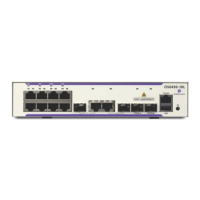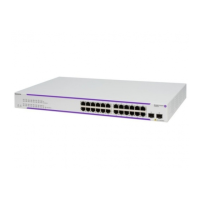OmniSwitch OS6860/OS6900/OS10K Troubleshooting Guide Part No.032996-00 Rev.A
AOS Release 7.X and 8.X January 2015
Alcatel-Lucent Page 70 of 148
9 256/255 256/256 256/256
1/1/(0) EFP 0/0 0 256/256 256/256 256/256
1 256/256 256/256 256/256
2 256/256 256/256 256/256
3 256/256 256/256 256/256</pre>
Combination of policy rules leading to multiple TCAM slices consumption
Rules of consumption
The number of configurable policies can be reduced due to the TCAM slice allocation. As explained before,
there are 4 TCAM slices available (remaining 4 slices are reserved) with 256 entries on each slice for user
configuration. Usually, while creating policy rules the system allocates the TCAM entries on the same slice
until the 256 entries are used then it moves to the next slice and so on up to exhaustion of all available entries.
Source slot-port rules and destination slot-port rules cannot use the same slice. L2 rules and L4
rules cannot use the same slice. Souce IPv6 and destination IPv6 rules cannot use the same slice.
Example of a mix of rules consuming different slices
Configuration
policy condition c1 source vlan 559 source ipv6 2001:4cd0:bc00:2570:1::1 destination tcp-port 80
policy condition c2 source vlan 519 destination ipv6 2001:4cd0:bc00:2570:1::1 source tcp-port 80
policy action a1
policy rule r1 condition c1 action a1
policy rule r2 condition c2 action a1
qos apply
TCAM Utilization
Source IPv6 rules and destination IPv6 rules cannot use the same slice pair. FPSs (Field Processing Selectors)
in the slice pairs are configured differently. A single slice pair cannot hold both rules r1 and r2, as a result
these rules are programmed in different slice pairs and each consumes 1 TCAM rule.
-> show qos slice
Slot/ Ranges Rules Counters Meters
Unit Type Total/Free CAM Total/Free Total/Free Total/Free
1/1/(0) IFP 32/32 0 128/128 128/128 128/128
1 128/127 128/127 128/128
2 128/125 128/125 128/128
3 128/127 128/127 128/128
4 256/255 256/255 256/256
5 256/255 256/256 256/256
6 256/255 256/255 256/256
7 256/255 256/256 256/256
8 256/255 256/254 256/254
9 256/255 256/256 256/256
1/1/(0) EFP 0/0 0 256/256 256/256 256/256
1 256/256 256/256 256/256
2 256/256 256/256 256/256
3 256/256 256/256 256/256
TCAM exhausted when hitting the system limitation, the importance of the policy rule precedence
The number of rules available on the system can be exhausted if switch hits the system limitation (rules
programmed on different slices or policy network group rules are not optimized).
Example 1: TCAM exhausted when the default precedence is used
Source IPv6 rules and destination IPv6 rules cannot use the same slice pair: The following combination of
source IPv6 rules and destination IPv6 rules forces the system to program each entry in different slice pair
because the user is letting the system using the default precedence order.
The rule precedence is based on the order in which the rule entry is entered or by defining the

